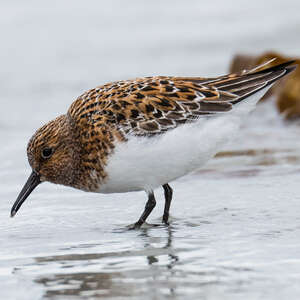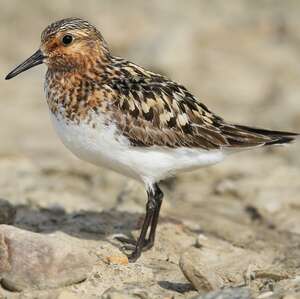Sanderling
Calidris alba - Bécasseau sanderling
Identification
The Sanderling is a medium sized sandpiper, slightly bulkier than the Dunlin. It is very closely linked to maritime environment during the inter-breeding season. In silhouette, it appears more compact and rounder than the Dunlin, an impression accentuated by its short beak, held by a rather large head and relatively short legs.
The adult in breeding plumage has the head, neck, top of the chest and upper parts invaded by a vivid shade of reddish-brown. Some individuals are paler on top, with the red replaced by a light beige shade, but with all individuals, the upper plumage is distinctly marked with black forming an irregular kind of chessboard pattern. The cap, nape and chest are streaked with black-brown. The lower parts, from the chest to the undertail coverts are pure white, creating a clear contrast. The beak is short and straight, shorter than the head length and fairly thick. The iris is dark. The legs are black and, as a unique character among waders, the foot lacks a hind toe, which can be a discriminating criterion when taking photos. Confusion with a breeding Little Stint is possible if the size cannot correctly be estimated. The Little Stint is smaller, with a thinner beak, and it has a hind toe.
The adult in winter plumage is completely different. It is grey and white. The upper parts are grey-ash with fringed feathers tipped white and with some, such as the scapulares, having a dark median streak. The grey cap is finely speckled. The face is white as are the lower parts, mostly excluding the upper part of the chest. When the feather of the chest do not cover it, the small dark coverts form a blackish patch in the wrist area, very visible in flight and diagnostic. To conclude, during this season a very pale bulky sandpiper running with agility on the seaside, which eliminates the possibility of a (similar) grey and white Little Stint, which can be found inland.The young bird of the year in post-nuptial migration is easily recognisable. The upper parts are pale gray-white and heavily marked with black. There is no brown or beige. The head, neck and upper chest are washed with cream russet. A sketch of the pectoral band can be seen. The blackish wrist patch stands out well.
A Sanderling in flight can be identified by its short bill, its well-marked and contrasting white wing bar with the dark wrist, its all-white underparts in all seasons, except for the upper chest and its cry.
Subspecific information 2 subspecies
- Calidris alba alba (Ellesmere I., n and e Greenland, Svalbard, Franz Josef Land and Taymyr)
- Calidris alba rubida (ne Siberia, Alaska, n Canada)
Foreign names
- Bécasseau sanderling,
- Correlimos tridáctilo,
- pilrito-das-praias,
- Sanderling,
- fenyérfutó,
- Drieteenstrandloper,
- Piovanello tridattilo,
- sandlöpare,
- Sandløper,
- pobrežník belavý,
- jespák písečný,
- Sandløber,
- pulmussirri,
- Drietoonstrandloper,
- territ de tres dits,
- Sanderla,
- piaskowiec,
- gaišais šņibītis,
- peščenec,
- Песчанка,
- Kedidi putih,
- ミユビシギ,
- 三趾滨鹬,
- นกคอสั้นตีนไว,
- 三趾濱鷸,
Voice song and call
Habitat
The Sanderling breeds in the high Arctic on the dry, stony tundra in well-drained areas, slopes or alluvial plains with sparse vegetation of willows, dryads, saxifrages, etc.
Behaviour character trait
Except in breeding season, the Sanderling, a sleek grey-pearl and white bird with black beak and legs, is a gregarious coastal bird. It lightly skitters about the sandy beaches like a wind-up toy. It rarely strays away from its peers, preferring to keep in close contact with them. At high tide, groups congregate on high spots and remain still. Migrants can also fly over land in their migration and make brief stops on fresh water.
Dietfeeding habits
During breeding season, the Sanderling feeds in wet parts of the tundra, alongside rivers of all sizes and within coastal areas if it is not too far away.
The prey consists mostly of insects, in particular Diptera (Tipulidae, Chironomids...) and their larvae, Coleoptera and other invertebrates (small crustaceans and molluscs). It can occasionally feed on vegetal items, such as young shoots, buds, seeds, algae and mosses.In the inter-season, it can be found in small flocks along the shoreline, trotting and pecking as the wave recedes before quickly receding when it returns. Agile and skillful, it captures small invertebrates (insects and their larvae, crustaceans, small mollusks, tiny polychaete worms...) on the surface and at a shallow depth in the substrate.
Reproduction nesting
The reproduction is late and happens at the end of June or July. The species is monogamous and territorial and the pairs nest separately.
The female lays 4 eggs (sometimes only 3) which are lightly spotted with brown on an olive background in a hollow lined with leaves under a tuft of vegetation. Incubation lasts 23-24 days and is done by the couple. If the first clutch is lost, the female can produce a second clutch and possibly a third if the second is lost. Movement towards the coasts starts as soon as the young become emancipated, in August.Geographic range
The Sanderling has a holarctic distribution. It breeds in the high Arctic of both the American and Eurasian continents, north of the Arctic Circle. It nests locally in northern Alaska, widely on the islands of the Canadian Arctic Archipelago, in the west and east of Greenland, in the Spitzberg and in the high Arctic of central Russia around the Kara and Laptev Seas and their islands (Northland and New Siberia Island). It does not nest in Iceland, Scandinavia, or even on New Zemble.
Threats - protection
IUCN conservation status
concern
in the Wild
threatened
evaluated
The species is not threatened. The general trend is uncertain, some populations are decreasing, while others are increasing, stable, or of unknown trend. The results of surveys in North America are rather encouraging with a positive trend. For the Arctic Europe, it is unknown (info BirdLife International).
Sources of information
- IOC World Bird List (v15.1), Gill, F and D Donsker (Eds). 2025-12-07.
- Limicoles, gangas et pigeons d'Europe, Paul Géroudet (mise à jour Georges Olioso)
- Shorebirds, an identification guide to the waders of the world, Peter Hayman, John Marchant Tony Prater
- Birds of the World, The Cornell Lab of Ornithology
- xeno-canto, Sharing bird sounds from around the world,
Other sources of interest
 Specification sheet created on
21/07/2023 by Jean François
Specification sheet created on
21/07/2023 by Jean FrançoisTranslation by AI Oiseaux.net
© 1996-2026 Oiseaux.net
- Accipitriformes
- Aegotheliformes
- Anseriformes
- Apodiformes
- Apterygiformes
- Bucerotiformes
- Caprimulgiformes
- Cariamiformes
- Casuariiformes
- Charadriiformes
- Ciconiiformes
- Coliiformes
- Columbiformes
- Coraciiformes
- Cuculiformes
- Eurypygiformes
- Falconiformes
- Galliformes
- Gaviiformes
- Gruiformes
- Leptosomiformes
- Mesitornithiformes
- Musophagiformes
- Nyctibiiformes
- Opisthocomiformes
- Otidiformes
- Passeriformes
- Pelecaniformes
- Phaethontiformes
- Phoenicopteriformes
- Piciformes
- Podargiformes
- Podicipediformes
- Procellariiformes
- Psittaciformes
- Pterocliformes
- Rheiformes
- Sphenisciformes
- Steatornithiformes
- Strigiformes
- Struthioniformes
- Suliformes
- Tinamiformes
- Trogoniformes
































